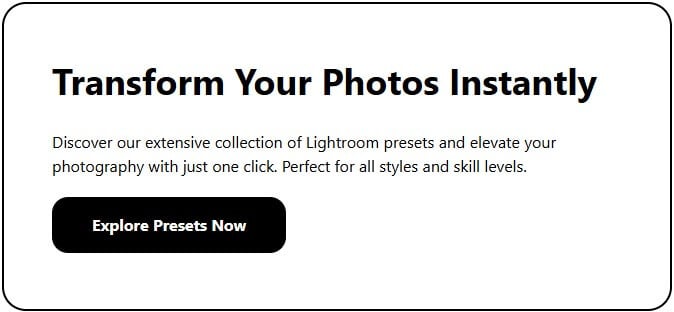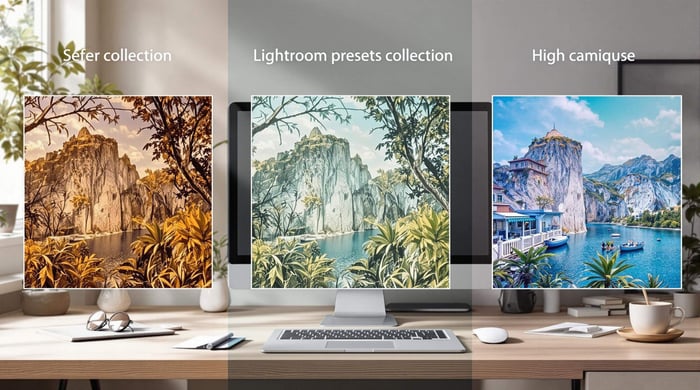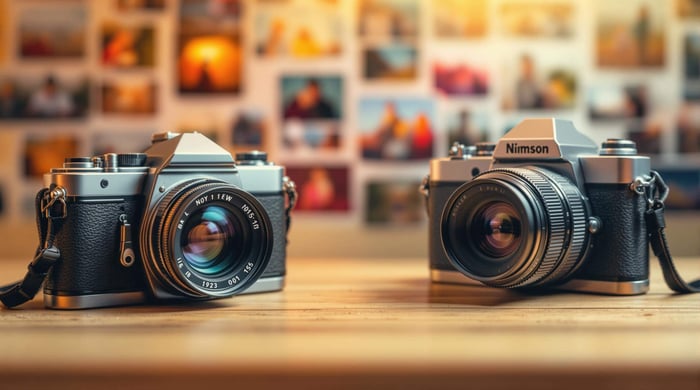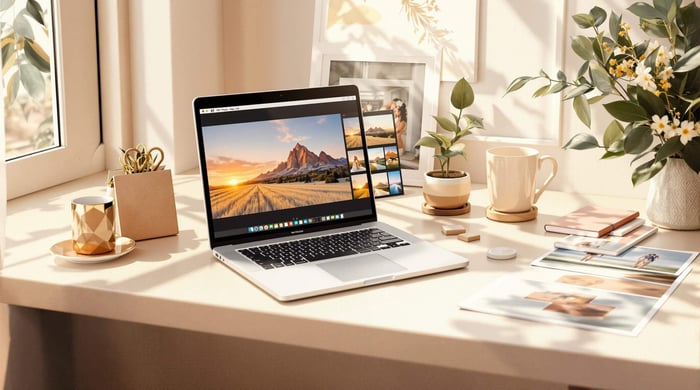Photo editing has transformed from basic filters to advanced AI-powered presets that save time and improve quality. Here's what you need to know:
- What Changed? Filters offered quick but generic edits. Presets now apply multiple adjustments at once, making editing faster and consistent.
- AI Integration: Tools like Adobe Lightroom's Adaptive Presets analyze your photo and apply tailored edits automatically.
- Why It Matters: Presets simplify workflows for all photography styles - portraits, landscapes, or social media.
- Top Tools: Adobe Lightroom, Luminar NEO, and Evoto AI help you use presets effectively.
Presets combine automation with customization, making professional editing accessible to everyone. Read on for tips to incorporate them into your workflow.
My Lightroom Workflow | Lightroom Presets and Production Tools
The Shift from Filters to Presets in Photo Editing
The Early Days: Filters and Manual Edits
Digital photo editing started with simple filters and manual tweaks that required both time and skill. Filters provided quick but generic changes, often leaving photographers with a tough choice: settle for imprecise edits or invest hours in manual adjustments. This gap highlighted the need for tools that could simplify editing while still offering creative freedom, leading to the development of presets [1].
The Rise of Presets in Editing Software
Presets brought a game-changing improvement to photo editing. Adobe Lightroom played a key role by introducing preset systems that could apply multiple adjustments at once. This made editing faster and more consistent while maintaining high-quality results. Suddenly, professional-grade editing wasn't just for experts - it became accessible to photographers at all levels. Over time, presets became even more advanced, with AI integration adding precision and flexibility to the process [1].
AI and the Next Step for Presets
AI has taken presets to the next level, turning them into intelligent tools that adjust to the specifics of each image. Adobe Lightroom's Adaptive Presets showcase this leap forward, using machine learning to analyze photos, identify elements, and apply tailored adjustments for polished, natural results [2].
Other AI-driven tools like Evoto AI enhance this process by working seamlessly with existing software, examining each photo's unique features to ensure that adjustments enhance rather than overwhelm the original image [3]. These advancements are reshaping post-processing, making top-tier editing faster and easier for everyone [2].
How Advanced Presets Improve Modern Photography
Why Advanced Presets Are Useful
Advanced presets simplify the editing process by automating repetitive tasks and ensuring consistent, high-quality results. They represent a major shift in editing, blending manual adjustments with smart automation. For instance, AI-powered tools like Adobe Lightroom's Adaptive A.I. analyze image details and apply customized adjustments. This saves time and enhances the natural look of photos [2].
These presets can be customized to suit the specific needs of various photography genres.
Using Presets for Different Photography Styles
Presets cater to the unique requirements of different types of photography. For portraits, they refine warmth and skin tones. Landscape presets bring out the dynamic range and intricate details, while presets for social media ensure a cohesive aesthetic across platforms. The NOSTALGIC Evolution AI Preset Collection is a great example of a tool designed to address these diverse needs [2].
Choosing the right software is key to maximizing the benefits of presets.
Top Tools for Using Advanced Presets
| Software | Key Features | Best For |
|---|---|---|
| Adobe Lightroom | Large preset library, AI-driven features, RAW file support | Professional workflows |
| Luminar NEO | AI tools with a user-friendly interface | Automated adjustments |
| Evoto AI | Easy preset management and AI effects | Beginners and intermediates |
These tools highlight how software continues to expand the possibilities of presets. Adobe Lightroom stands out with its vast preset options and advanced masking features for precise edits [1] [4]. Meanwhile, Evoto AI simplifies preset management, making it easy to save custom edits and import presets from other sources [3].
Adding Advanced Presets to Your Editing Process
How to Use Presets: A Step-by-Step Guide
Here’s how to make the most of advanced presets in your editing workflow:
Choose and Apply a Base Preset
- Pick a preset that aligns with the look you're aiming for.
- Apply it to your image and review the initial outcome.
- Factor in the type of image and the mood you're trying to create.
Fine-tune the Results
Focus on these three areas to refine your edit:
- Adjust basic settings like exposure, contrast, and highlights.
- Work on color grading to create the right mood or atmosphere.
- Use local adjustments to tweak specific areas of the image.
These steps lay the groundwork for achieving polished, professional-quality results.
Adjusting Presets to Fit Your Style
After applying a preset, tweak it to reflect your personal vision. Here's how to customize presets to make them your own:
- Use sliders to control the intensity of effects.
- Adjust color profiles to suit the lighting in your image.
- Save your modified presets for future use.
For instance, Adobe Lightroom's Evolution Presets Collection offers 48 color and 6 black-and-white presets [1], which can serve as a great starting point for crafting your unique style.
Organizing and Managing Presets Effectively
Once you’ve customized your presets, keeping them organized is key to a smooth workflow. Set up a clear system by grouping presets into folders based on their purpose:
| Category | Examples | Purpose |
|---|---|---|
| Style | Portrait, Landscape, Street | Quick access to genre-specific presets |
| Color Profile | Warm, Cool, B&W | Easy selection for setting the right mood |
| Project | Client Work, Personal | Ensure consistency across related images |
Give your presets descriptive names so you can locate them quickly. Tools like Evoto AI make it simple to save and import custom edits [3], helping you stay organized and efficient.
Conclusion: The Future of Photo Editing with Presets
Key Takeaways
Photo editing has come a long way - from simple filters to advanced preset systems that combine efficiency with creative freedom. Modern presets simplify editing workflows, offering a mix of automation and control, and they allow photographers to achieve polished, professional results faster. AI-powered presets, in particular, are making detailed, high-quality editing more accessible, especially when working with RAW files.
These tools build on earlier presets, giving photographers more options to bring their creative ideas to life. As AI continues to evolve, its influence on photo editing is only expected to grow.
The Role of AI in the Future of Photo Editing
Adobe's recent work with Sensei AI technology hints at a smarter, more intuitive future for photo editing. Their 2023 statement highlights this shift:
"New Adobe Sensei AI-powered features empower intuitive editing and seamless workflows" [4]
This signals a movement toward tools that adapt to individual photographers' needs. Here’s a glimpse of what AI advancements could bring:
| AI Feature | Impact | Benefit |
|---|---|---|
| Intelligent Content Analysis | Automatically applies adjustments based on image content and learns a photographer's style | Saves time with personalized, automated edits |
| Dynamic Adjustment | Modifies edits in real-time based on shooting conditions | Ensures consistent quality in varying lighting |
| Advanced Integration | Connects seamlessly with new technologies and platforms | Simplifies editing across devices and software |
Future tools will use smarter algorithms to balance technical accuracy with creative expression. This will allow photographers to focus on their art while letting AI handle the technical details, making professional-level editing accessible to everyone, no matter their experience.


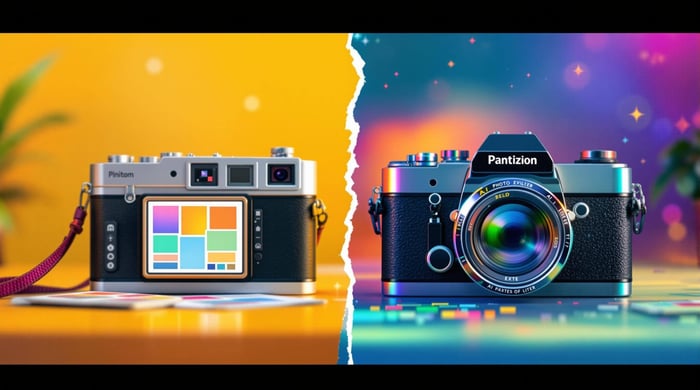
.png)
